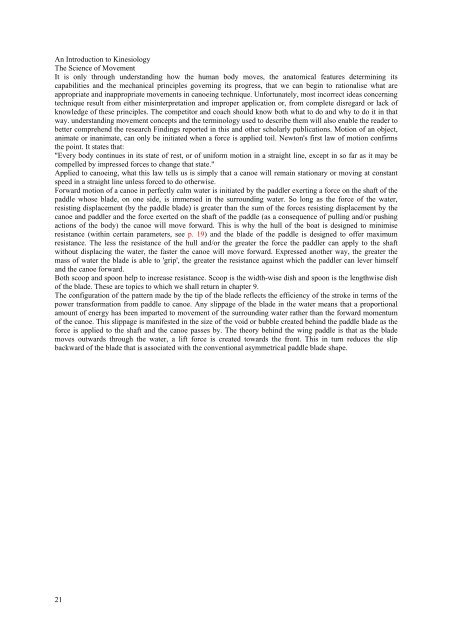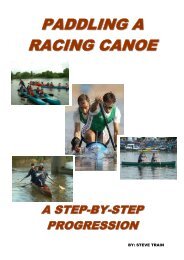The Science of Canoeing By Richard Cox
The Science of Canoeing By Richard Cox
The Science of Canoeing By Richard Cox
Create successful ePaper yourself
Turn your PDF publications into a flip-book with our unique Google optimized e-Paper software.
An Introduction to Kinesiology<br />
<strong>The</strong> <strong>Science</strong> <strong>of</strong> Movement<br />
It is only through understanding how the human body moves, the anatomical features determining its<br />
capabilities and the mechanical principles governing its progress, that we can begin to rationalise what are<br />
appropriate and inappropriate movements in canoeing technique. Unfortunately, most incorrect ideas concerning<br />
technique result from either misinterpretation and improper application or, from complete disregard or lack <strong>of</strong><br />
knowledge <strong>of</strong> these principles. <strong>The</strong> competitor and coach should know both what to do and why to do it in that<br />
way. understanding movement concepts and the terminology used to describe them will also enable the reader to<br />
better comprehend the research Findings reported in this and other scholarly publications. Motion <strong>of</strong> an object,<br />
animate or inanimate, can only be initiated when a force is applied toil. Newton's first law <strong>of</strong> motion confirms<br />
the point. It states that:<br />
"Every body continues in its state <strong>of</strong> rest, or <strong>of</strong> uniform motion in a straight line, except in so far as it may be<br />
compelled by impressed forces to change that state."<br />
Applied to canoeing, what this law tells us is simply that a canoe will remain stationary or moving at constant<br />
speed in a straight line unless forced to do otherwise.<br />
Forward motion <strong>of</strong> a canoe in perfectly calm water is initiated by the paddler exerting a force on the shaft <strong>of</strong> the<br />
paddle whose blade, on one side, is immersed in the surrounding water. So long as the force <strong>of</strong> the water,<br />
resisting displacement (by the paddle blade) is greater than the sum <strong>of</strong> the forces resisting displacement by the<br />
canoe and paddler and the force exerted on the shaft <strong>of</strong> the paddle (as a consequence <strong>of</strong> pulling and/or pushing<br />
actions <strong>of</strong> the body) the canoe will move forward. This is why the hull <strong>of</strong> the boat is designed to minimise<br />
resistance (within certain parameters, see p. 19) and the blade <strong>of</strong> the paddle is designed to <strong>of</strong>fer maximum<br />
resistance. <strong>The</strong> less the resistance <strong>of</strong> the hull and/or the greater the force the paddler can apply to the shaft<br />
without displacing the water, the faster the canoe will move forward. Expressed another way, the greater the<br />
mass <strong>of</strong> water the blade is able to 'grip', the greater the resistance against which the paddler can lever himself<br />
and the canoe forward.<br />
Both scoop and spoon help to increase resistance. Scoop is the width-wise dish and spoon is the lengthwise dish<br />
<strong>of</strong> the blade. <strong>The</strong>se are topics to which we shall return in chapter 9.<br />
<strong>The</strong> configuration <strong>of</strong> the pattern made by the tip <strong>of</strong> the blade reflects the efficiency <strong>of</strong> the stroke in terms <strong>of</strong> the<br />
power transformation from paddle to canoe. Any slippage <strong>of</strong> the blade in the water means that a proportional<br />
amount <strong>of</strong> energy has been imparted to movement <strong>of</strong> the surrounding water rather than the forward momentum<br />
<strong>of</strong> the canoe. This slippage is manifested in the size <strong>of</strong> the void or bubble created behind the paddle blade as the<br />
force is applied to the shaft and the canoe passes by. <strong>The</strong> theory behind the wing paddle is that as the blade<br />
moves outwards through the water, a lift force is created towards the front. This in turn reduces the slip<br />
backward <strong>of</strong> the blade that is associated with the conventional asymmetrical paddle blade shape.<br />
21



